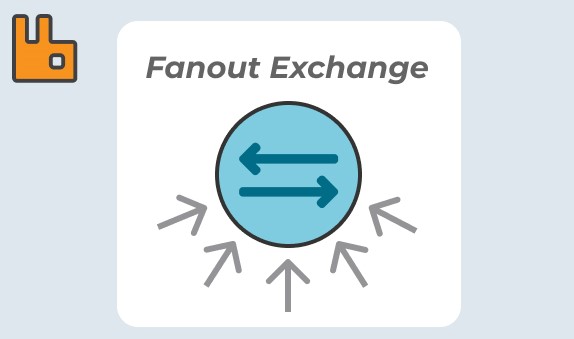RabbitMQ Fanout Exchange with Golang: Beginner's Guide
 Shivam Dubey
Shivam Dubey
A Fanout Exchange is another important type of exchange in RabbitMQ. Unlike the Direct Exchange, which routes messages based on routing keys, a Fanout Exchange delivers messages to all queues bound to it, regardless of any routing key.
In this article, we’ll cover:
What is a Fanout Exchange?
How it works with a clear flowchart.
Implementing Fanout Exchange with Golang.
Detailed line-by-line explanation of the producer and consumer code.
🧑💻 What is a Fanout Exchange?
A Fanout Exchange routes messages to all queues bound to it without considering a routing key. This is ideal for scenarios where a message should be delivered to multiple consumers simultaneously.
Producer sends messages to the exchange.
Exchange routes the message to all queues bound to it, without checking any routing key.
Consumers receive messages from the queues.
📊 Flowchart: How Fanout Exchange Works with Routing Key
In the Fanout Exchange, even though the routing key is provided by the producer, the exchange ignores the routing key and sends the message to all queues bound to it.
+-------------------+
| Producer |
+-------------------+
|
|
+--------------------+
| Fanout Exchange |
+--------------------+
/ | \
______/ | \______
/ | \
+---------+ +---------+ +---------+
| Queue 1 | | Queue 2 | | Queue 3 |
+---------+ +---------+ +---------+
| | |
+------------+ +------------+ +------------+
| Consumer 1 | | Consumer 2 | | Consumer 3 |
+------------+ +------------+ +------------+
Queue1, Queue2, and Queue3 are all bound to the Fanout Exchange.
The Producer sends a message, for example, with the routing key
info.Fanout Exchange ignores the routing key and sends the message to Queue1, Queue2, and Queue3.
All consumers connected to these queues will receive the message.
🛠 Prerequisites
Install RabbitMQ.
Install Go.
Install the RabbitMQ client library for Go:
go get github.com/streadway/amqp
🚀 Producer Code
package main
import (
"log"
"github.com/streadway/amqp"
)
func main() {
// Step 1: Connect to RabbitMQ Server
conn, err := amqp.Dial("amqp://guest:guest@localhost:5672/")
if err != nil {
log.Fatal(err)
}
defer conn.Close()
// Step 2: Create a channel
ch, err := conn.Channel()
if err != nil {
log.Fatal(err)
}
defer ch.Close()
// Step 3: Declare a Fanout Exchange
err = ch.ExchangeDeclare(
"logs", // Exchange name
"fanout", // Exchange type (fanout)
true, // Durable
false, // Auto-deleted
false, // Internal
false, // No-wait
nil, // Additional arguments
)
// Step 4: Publish a message to the exchange
err = ch.Publish(
"logs", // Exchange name
"", // Routing key is ignored
false, // Mandatory flag
false, // Immediate flag
amqp.Publishing{
ContentType: "text/plain",
Body: []byte("Hello, World!"), // Message body
},
)
if err != nil {
log.Fatal(err)
}
log.Printf(" [x] Sent 'Hello, World!'")
}
Producer Code Explanation
Connecting to RabbitMQ:
amqp.Dial("amqp://guest:guest@localhost:5672/"): Connects to RabbitMQ using the defaultguestcredentials. If the connection fails, the program exits with an error message.
Creating a Channel:
conn.Channel(): Creates a communication channel. All operations in RabbitMQ (publishing, consuming) happen through a channel.
Declaring the Exchange:
ch.ExchangeDeclare: This declares a Fanout Exchange namedlogs. The typefanoutis specified, which means messages will be sent to all queues bound to this exchange.
Publishing the Message:
ch.Publish: This sends a message to the exchangelogs. The routing key is left empty because it is not used by a Fanout Exchange. The message body is"Hello, World!".
🚀 Consumer Code
package main
import (
"log"
"github.com/streadway/amqp"
)
func main() {
// Step 1: Connect to RabbitMQ Server
conn, err := amqp.Dial("amqp://guest:guest@localhost:5672/")
if err != nil {
log.Fatal(err)
}
defer conn.Close()
// Step 2: Create a channel
ch, err := conn.Channel()
if err != nil {
log.Fatal(err)
}
defer ch.Close()
// Step 3: Declare a temporary queue
q, err := ch.QueueDeclare(
"", // Empty name for a temporary queue
false, // Durable
true, // Auto-deleted
false, // Exclusive
false, // No-wait
nil, // Additional arguments
)
if err != nil {
log.Fatal(err)
}
// Step 4: Bind the queue to the Fanout Exchange
err = ch.QueueBind(
q.Name, // Queue name
"", // No routing key (ignored by Fanout Exchange)
"logs", // Exchange name
false, // No-wait
nil, // Additional arguments
)
if err != nil {
log.Fatal(err)
}
// Step 5: Start consuming messages from the queue
msgs, err := ch.Consume(
q.Name, // Queue name
"", // Consumer tag (empty string means automatic generation)
true, // Auto-acknowledge
false, // Exclusive
false, // No-local
false, // No-wait
nil, // Additional arguments
)
forever := make(chan bool)
go func() {
for d := range msgs {
log.Printf("Received message: %s", d.Body) // Log the received message
}
}()
log.Printf("Waiting for messages...")
<-forever
}
Consumer Code Explanation
Connecting to RabbitMQ:
amqp.Dial("amqp://guest:guest@localhost:5672/"): Connects to RabbitMQ using default credentials.
Creating a Channel:
conn.Channel(): Creates a channel for communication.
Declaring a Temporary Queue:
ch.QueueDeclare: Declares a temporary queue with no name (""). This queue is auto-deleted when the consumer disconnects. It is exclusive and non-durable.
Binding the Queue:
ch.QueueBind: Binds the temporary queue to thelogsexchange. The routing key is empty since Fanout Exchange ignores routing keys.
Consuming Messages:
ch.Consume: Starts consuming messages from the queue. The consumer automatically acknowledges messages (sinceautoAckistrue).
Message Handling:
- The consumer logs each message it receives from the queue.
✅ Key Takeaways
Fanout Exchange sends messages to all bound queues regardless of any routing key.
It is useful in scenarios where you need to broadcast messages to multiple consumers.
The producer sends a message to the Fanout Exchange, and all queues bound to this exchange will receive that message.
Subscribe to my newsletter
Read articles from Shivam Dubey directly inside your inbox. Subscribe to the newsletter, and don't miss out.
Written by
